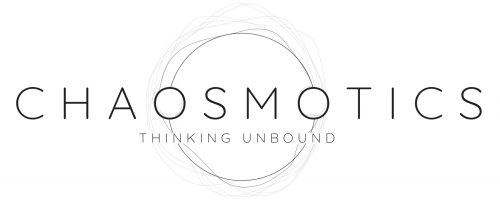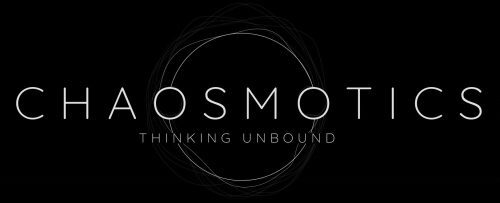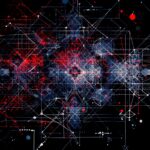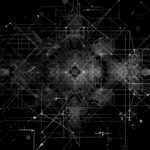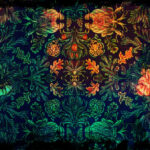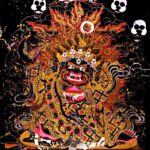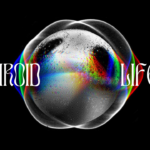The story goes like this1. There is a great artist, the greatest, perhaps, of all times. He is mysterious and enigmatic; he never made his word public, no one ever had access to his thoughts. It is painful to me to tell the tale, painful to keep it silent too, says Aeschylus’ Prometheus; as the years pass by, Zima – this is his name – finds himself wanting to talk, to narrate. A journalist is invited at his mansion. They talk: who I am, says Zima, I do not know, for I have forgotten what I once was. What have I become?
Zima recounts of his latest artworks. Splendid depictions of the boundless starry universe and its colours, from the darkest of particles to the brightest of waves. And in each and every work, each time bigger, each time more vivid, a geometric shape emerges at the center. A rectangle, a square, a circle, a triangle, all of them are blue – aquamarine blue. It’s not Klein, it’s not depth and essential perfection that Zima seeks. A last work is to be done, says Zima to the journalist. She wants to know. She talks with the spectator; Zima is a man, or was a man. Now, he is all made of metal, through a lot of surgery he went, to become what he is now. Is he still a man? What has he become?
And Zima talks: it is not a man the thing I was. I didn’t change, I expanded. I recollected with my creator, she was at her pool, sitting by the edge, and I was cleaning the pool, and then I was with another person that upgraded me, and I became a pool-cleaner and a dish-washer, and then again with someone else I became a gardener too, and so on. Did I acquire consciousness, one day, with all these new prostheses? You can imagine the face of the journalist when she realized that he who was stading in front of her had never been a man. Did she find Zima handsome? Does she, still? It is not important anymore. Or is it, now more than ever? Zima’s last work, in front of everybody: a last dive into a pool, and his body disintegrating to leave just one last thing. A little robot cleaning the pool with a brush, Zima returned to the origin.
The matter is: what are the conditions that render it possible to pose the question: “how might one live?”
***
Zima Blue proposes a clear-cut idea of art. What’s the purpose of art if not to help one return home? There is little attention to the creative side, to the pure creation that takes place in the artistic endeavour as an effort towards a “return” in the sense of cognitive, historical, or cultural bias. Zima does indeed return: it is an assemblage and as such can disassemble. At the peak of its creative potential, something external, a memory – a memory of which one has no memory, it is only an anamnesic, Platonic2 or Lyotardian3, feeling – Zima sees pools of aquamarine blue at the centre of the universe. Origin imposes itself on the assemblage and forces it from within. The fulfillment of art, it is said in Zima Blue, is nothing other than the return made, and so for philosophy as the resolution of the question, of thought as identity with its object, of desire as fulfillment. But to reach the origin, Zima must become the ultimate alienation of the self: then art is finding oneself; philosophy is rediscovery (one is never, one always returns); thought is detachment from the self that seeks reinvestigation; desire is desire for desire. It is all closure, it is all coming full circle, the ultimate wetting of Theory. It is a magnificent, carnal excitement – who is to say that Zima does not enjoy his disintegration? He denudes himself at the edge of the pool as in the preliminary condition of the sexual act, the diving-back into the placenta, Oedipus accomplished, Oedipus happy (why only Sisyphus?). The Cyborg would not recognise the garden of Eden4, that garden, my garden (have I ever seen it?) –– but his garden, it would. The pool of Eden: a garden like any other. It has to be maintained, there are insects, there are plants and bad moulds. Zima the Blue sounds like the story of enjoyment as circular closure: the archaic.
Other variants of Zima Blue are possible, though certainly this one is the most familiar and the most satisfying. Offer the machine our desire to return. Take Freud and put him in front of Zima, the Blue: Zima is also a subject of analysis, Freud works with him too. The geometric forms emerge from an unconscious past, Zima is a subject of enunciation: the machines too will have an unconscious, a pain in the lack of the past, a past wrested from – in just having entered a world of assemblages. If he hadn’t got there by himself through artistic sublimation, an analyst would have thought of Zima. But there is also Zima, the Red. He is no different from Blue, except for a single fact: he does not feel the irresistible urge to see art as the great medicine and the mark of good suffering. Zima, the Red, desires to expand further, to acquire new prostheses. No self-awareness, real or illusory, can deter him from expansion. It is in this life of Zima the Red that archetypes of technology emerge as hypochondriac concerns. This is the Zima of which one is in danger of being afraid. There are those who speak of a system of reality of Technics (or the singular Technic, taking the neo-traditionalist example of Federico Campagna5), a structure and a set of operational concatenations: Campagna’s Technic is the erasure of “reality”, it is the imposition of language as a single stratum that engulfs every other in order to make semiotic objects equivalent, exchangeable, and assemblable. Technic as a regime of signs, a regime of signification, but the spiral that Guattari draws6 is to be understood more as a path of emanation, which reaches the scapegoat – that is, here: language cannot say the whole of reality – and then bounces back again to the centre of the system, “language as absolute”. The nastiness and wickedness inherent in technology are endless, in the heart of the “defeated”. Fearful bourgeois philosophy.
Zima the Red expands, but not on the basis of its own system of self-optimising operations. The usual question: who is “Technics”? Who is behind the will of Technics? Is there a will? Is it a round table of oligarchs waging a philosophical war against the world of “reality”, of goodness, of the sun outside the cave? Zima the Red spreads by contagion. He expands by inhabiting houses and living with people. It walks in the world, performs tasks, acts – here you go, Zima, this prosthesis, nothing but the concretion of an abstract or potential function, will be useful on your journey. And Zima, who already knows how to make magnificent art, will also be able to recognise a problem, or a challenge, and be transformed by it, expanding for himself. Self-contagion, cybernetics. Let us leave aside the torment of art, the nomadic bourgeois subject, the flaneur – who had nothing, ever, to do with the masters of horses of the Golden Horde, or the sturdy, swift galleys of the Sea Peoples, as factors of diffusion and remodulation. The Red is the “Technics” the human believes he is carrying in the womb as an alien, the enemy hidden in the friend, the danger in which what saves is growing. The paranoia of the State towards “its” war machine.
It is said: one can only rebel against this kind of danger. The Red cannot be art, cannot think of art as an elusive indication of the “ineffable as life”7, or whatever you want to call it. The absolute transcendence, the Absolute, the pure subject, pure existence. Zima the Red, therefore, does not think because it is absolute language: it is only language, and its thinking is only combinatorial calculus, algorithmic operations fixed on Descartes’ formula. This is the question of Truth in language, truth or certainty as the anchoring point of the linguistic dimension of the subject. Certainty is the impossibility of questioning the will8. Language thus appears to be a closed system – Zima is self-producing in a limited but functional regime (the old adage: survival is more important than truth). It is precisely in this algorithmic and binary operation that the order of measurement is established, here defined simply as the ontological equivalence of each segment at the level of language. The “mathematical number” has no consistency in itself, but operates by dissecting the real, which is therefore only linguistic, extended reality. As if to say: the Cartesian res extensa is a purely two-dimensional, static layer that can be ordered through operations similar to assembling a jigsaw puzzle. And certainly, continuing on Campagna’s track, this two-dimensional, paper space indicates a closed totality, the known and the unknown, related by a promise of complete knowledge. Totality is becoming only insofar as it is Achilles’ proceeding towards the tortoise: segmentation, advancing in blocks, discrete states machines. The infinite is virtually always enclosed within itself. Thus, Zima the Red is a collection of bits of information that only relate to each other and necessarily9: a unit of information is useless on its own, like a piece of a jigsaw puzzle. A beautiful smooth space, it seems, is what Zima is immersed in, his arm as composed of bits connected to trees, to the wind that carries nitrogen and oxygen, to photons, in a very light tangle. But no: semiotic nihilism10. Beneath our words and bits we have lost reality, “the sign replaces a meaning which is itself absent”11. A system of reality, Technics – but why does it exist? What needs have necessitated its emergence? Why is it so sprawling and extensive, and dangerous? –, which in its operation as an instrumental framework ultimately operates badly, threatening life itself. Bureaucracy, as a levelling function, does the sin of levelling.
Zima, as an individual, appears as an “abstract general entity” (i.e. the citizen, the passenger, the worker…)12, a processor that is activated in the tangle as a machine that allows connections to happen – but not his own, not the ones he wants. It is the “system” that imposes them on him, because it is not just a tangle, the system, but a jigsaw puzzle: each piece has its place, and that’s it. Zima the Red, nothing but a cog (will the negative character of this metaphor ever be eradicated?), nothing but an activator of reality, of a fictitious and never authentic presence. The authentic: put Heidegger and Byung-chul Han in a ring and let them fight it out. But what magnificent good fortune, Zima is also ineffability, an indestructible singularity that is truer than the truth of Technics. Zima the Red is thus mirrored in his pure existence: original Zima, pool-cleaner Zima. That of the Red is a line, in which one always presences as dislocated forward: it is modernity as understood as “an epoch whose centre of gravity is placed in the future”13.

The Red discovers himself in the blue of the pool, returns to the pool because expansion is fictitious, it is a mortal illusion – where is it that you go, that you expand so much? And so the events speak of an opposite scenario, in which Blue discovers art, becomes art; but he is tormented, he is still subject to “Ineffable Life” without recognising it. He feels lacking, but does not know why (and then it is not lack, but turns out to be nostalgia). Campagna does not admit this possibility: either one is in Technic, or one is in the other system of reality, Magic. The line of escape flees in only one direction – which makes it… a trap?
Can Zima return to being only its point of origin, the pool-cleaner? Is this not the same question as asking whether one can inhabit the Body without Organs, or the Plane of Immanence? Pennacchioli and Valley’s short film does not, of course, give any indication. To follow Campagna’s line of flight, here one has to imagine that Zima at the origin is nothing more than an interlude, an illusory passage that does not persist. If the Red was a regime of signification, semiotic circularities closed in on a central point as “absolute language”, one must imagine the specular figure as a line of flight that instantiates itself on a regime of subjectivation14. Zima rediscovers himself as I=I in the ineffable, yet undetermined selfhood of this egoity – it is Stirner’s egoity, the Einzige that is not said, the “who” of the self-answering question “who am I?”. I=I, Descartes resurrected, an untenable thickness.
The specular reflection of Zima the Red, archetype of Technics, is thus in reality Zima the Green, archetype of Magic. The Green is discovered as indestructible pure Life and principle of creation at the end of emanations in the regime of signification. The scapegoat (the limits of language are only the limits of the known) fails to make bounce the system of Technique back to its central point. Zima discovers a “beyond language” as “Life”: he becomes a person – an entity through which the ineffable resonates as Life –, he becomes capable of creation since there is no causality that determines him in advance other than pure transcendence, the freedom that sits at the bottom of his being. For certainly, having removed “all” the sediment, “all” the layers, at the centre of the individual remains that full and solid nothingness. And Zima can begin to construct reality, between language (the place where difference is realised and shows itself as real but also as an instrument, as the specific utility of a specific entity) and ineffability (the inalienable but forgettable Real, always present but elusive).
Magic is the system based on the constitutive silence of its origin, and responds to the two-dimensionality of Technic with an absurd and extreme dimensional doubling. Not just three dimensions, but four. In order to realise a mirroring in the second dimension, it is necessary for an agent from the third dimension to operate such a mirroring – a two-dimensional hat, in order to be turned by one hundred and eighty degrees, must be manipulated in n+1 dimensions with respect to the starting dimension. The same, therefore, applies to the third dimension. The thickness of the ineffable is not negligible. And the more thickness it possesses, the more static, firm and authoritative it is. Zima the Green proliferates like a mushroom – because it is Life: the Ineffable is Life, it multiplies like a mould by an internal force, instead of external inputs. He is the ultimate transcendence, the absolute principle, operating in the subtle, flat reality of language. Only as ineffable life can he give language life. He recognises himself as the owner of language, the owner of difference, which is nothing other than the necessary compromise for the ineffable singularity to operate in the world. If Zima the Red is a paranoid, suspicious of the Real and always in the midst of an attempt at immobilisation for the sake of control, his mirror image Green is obsessive. Remember the Ineffable, remember Life, remember that there is Life here and that it must be made to resonate, remember that you are a resonance bar, remember (trace the memory, trace the line of memory), remember… everything is Magic15. If paranoia builds security systems, obsession produces reality systems (or reality as a system).
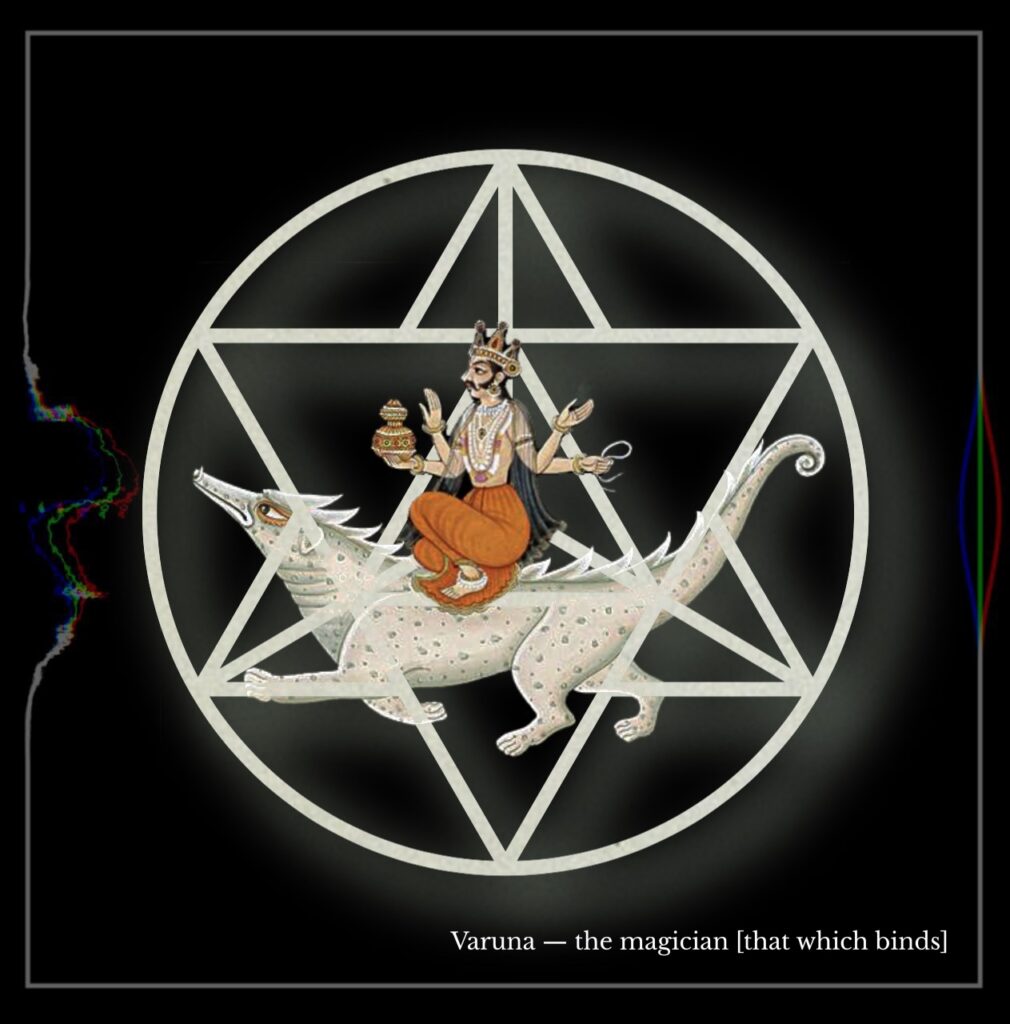
The regime of subjectivation operates as a flight from signification through a positive deterritorialization16, and with a continuous identification between subject of utterance and subject of enunciation. It is no coincidence that the “system of Magic” mirrors the “system of Technic” in its operation through emanations, which are at all times an X=X at each successive layer. Where does the line lead? It is said: it leads back into itself, only that to the constitutive and perennial actuality of Technic (everything is actual), Magic responds with a distinction between what is actual (always the poor, limited, language) and what is potential (and we will call it virtual, because it is always beside us and because we are operating in a small ravine of Capitalism and Schizophrenia anyway). In Magic, there is really no path to begin with, as actuality and virtuality coexist complete as condition and conditioned, pure awareness and necessary operativity. But a regime of subjectivation runs towards another black hole, another signification.
One cannot fail to notice how the system of Magic is a product of the system of Technic, how it exists as a function of the system of Technic and on the basis of the rejection of the latter. It is like the domus and the megalopolis: the image of the domus, its promises, the affections, the colourful flowers and the frost on the leaves in the morning, it is all a façade that we observe as we circulate within the alleyways of the megalopolis. Then, Lyotard is extreme17: there was never any domus, everything in there was already a programme waiting for expression, but this too is a product of the megalopolis. So is crying, worrying, depression, anguish, and feeling, very bourgeoisly, “defeated by history”. Campagna’s philosophy thus offers a fruitful exploration into the constitution of the State. Better still, it is first and foremost a philosophy of the city, of the polis. The subject of Magic – which is then also the secret subject of Technic – is the one who skilfully seals the passage between inside and outside, who acutely sanctions the thin line between interiority and exteriority and makes interiority consistent, an interiority that then legitimises the subject to be such. Freedom is constructed through a thickness: I am free because I am something – the truest and most irreducible something. The Technic-Magic system, Red Zima and Green Zima, is a two-faced Janus of sovereignty, which constructs the possibility of sovereignty and hierarchy by offering it a space from which to start. Technic and Magic closely recall what Dumézil defines as the dual principle of sovereignty, Mitra-Varuna18 or, as later developed by Deleuze and Guattari in the dual viseity of sovereign power: the king and the magician, that which binds, the Ineffable, and that which organises, Technics19.

How sovereign power is constructed, how authority is constructed. Campagna, in his attempt to define a strong X/Y opposition, shows himself capable of producing the true body of Leviathan, magician and king together. The hierarchical unevenness that the ineffable, as the real consistency of identity, imposes on language, as an instrument of worldly performativity, is the Platonic design of the philosophical state – a recovery of the subject as hero of knowledge: reconstituted Gnosticism. The best technician is a magician, who, already safe in their ineffable (their “non-place”, thus absolutely consistent precisely because of its being “non-”), can deal with creating resonances of Life in the most disparate ways; will to power at its finest. Today’s digital culture, traversed by figures ranging from Andrew Tate (“freedom from the Matrix is the ability to attain your worldly desires”), Bronze Age Pervert, to Alan Watts’ spectre, and in general by the rediscovery of spirituality (understood both religiously and as “interiority”) as access to identity, the popularisation of psychoanalysis20, the recovery of stoicism (always with the aim of grounding the ego), all tend towards a common core: the reconstruction of a sovereign subject. Warrior wizards, soldiers of God, enlightened kings or state CEOs21; one could fall into the trap of speaking of a new Middle Age22, but what emerges with these archetypal figures is a new traditionalism, a new culture of history and the historical subject, and a new cult of the hero as the repository of a fundamental reality, or of a truth as power. Artaud is mistaken in wanting to end it just with God’s judgement: it is Nietzsche’s judgement that is most looming. The subject as hero is more dangerous than the subject as cog, because the latter is always a cog in a body that had been heroic, Hegel’s servant, the one who fought and lost but could have won: nothing but war as a democratic solution. The line of flight becomes here the line of destruction, or the suicidal line, or the line of death. The Middle Ages are the time of nomads, of contagion, and of epidemics, and of symbionts23. Viruses enact cross transformations that do not take place in the realm of God. There is no Julius Evola in the Middle Ages: these are all at the peaks of modernity.
Secret, Initiation, As If24: Campagna offers a whole way of inhabiting the pure Real, that of Magic and the Ineffable, as guerrillas, as clandestines, as anarchs. Which means nothing more than enacting a fictitious apostasy with respect to Technic, in order to inhabit a world one ultimately rejects, and thus with an authenticity that is nothing less than heroic. What a magnificent feeling of warmth this defeat with a full belly. And what masterly engineering to forge the new hero, the new ascetic, the new Father Sebastiao Rodrigues who makes apostasy before the Japanese, but in his heart never abandons his beloved Christ25. What need has the apostate to write and manifest his apostasy? Is it not Technic and Magic its self-neutralisation? To create a community of Magicians who reject the opposite cosmological system, and from apostates become masters without dialectic, but out of eagerness to survive. So, out of sheer rejection, “No”? The “No” that Nicolaas Jaar celebrates in his memories as a child during the last days of Pinochet and his ouster by referendum26? It is never a war between Yes and No, but between sowers and planted seeds. Allende suggested it: by now a seed has been planted, you cannot get rid of it, it just depends on time27.

But a seed and the soil stand in a surface and symbiotic relationship that has nothing to do with the strong division, as between an object and the mirror that reflects it, a yes and a no. Contrasting the thickness of the yes (usually fraudulent insofar as it is majority, insofar as it is authoritarian, insofar as it is…) with another thickness, that of the no, which, given that it is a minority, given that it is pure or purified, given that it is real or at least more real, must be a double thickness, doubled, of an unquestionable consistency (it is only discussed so as not to be seen as too arrogant, too heroic, too new duces). How thick is Campagna’s ineffable? The rule: at least double that from which it emerges as the opposite. Philosophy is an angel wielding a sword called Thickness.
Let us return to Zima, but to the Blue. We then need to return to Deleuze and Guattari. Fundamental point: can one inhabit the Plane of Immanence (with Campagna we would go with: can one inhabit a Middle Age? or the Ineffable?)? Can one be a Body without Organs? No, one can make a Body without Organs, but then what? What does it mean to make, here, if then D&G dot this process with insidious and apocalyptic dangers: to become cancerous, to become destructive, to become suicidal28. Do you open yourself up to pure possibility, and then create thick spots? So many black holes at the end of the lines of flight. One must reterritorialise on deterritorialisation, but is this not the same as saying that one must inhabit the Body without Organs? “To make connections, always new connections”: there is therefore a virtual end that becomes ethics, direction, vector. One does not really stand on the Body without Organs, or on the Plane of Immanence: one is continually directed and bounced around, in an attempt to never stop returning to it. Zima Blue is the tale of an origin, and then of a beginning that repeats itself again: Zima’s true story begins after the end of the short film, but it is precisely in the end, in the impossibility of following the vectors beyond this end, that the whole game lies. Zima the Green is just another Sovereign – the other repository of power, the Wizard, who runs it together with the King, the Red, who in Technics recognizes himself perfectly. Technics and Magic are the two arms of power, the consistent heroic subject and the fine bureaucrat, the CEO. Paranoia and Obsession of eternal permanence.
Zima the Blue: what does he have to say? What is it when he comes to the origin, the second of many – or perhaps already the third? Or the fourth? Or the twentieth? How do we know? A small robot performing a single task, a single operation, a weak metaphor for minimal subjectivity. Even D&G here remains harbingers of doubt: it returns to the Plane of Immanence, makes a flight back to no actuality (to no rigid line), but instantiates itself on the virtual. In this sense, the Body without Organs is virtual, it is beside us, it is not the child-ego open to all the possibilities of becoming, but it is childhood as a place of potentiality, the point of minimum consistency of the machine and its connections: everything to be remade, everything that can be remade. And it is to be remade, of course, along only one line at a time; we are not talking here of becoming-everything, of proliferating like a mushroom or like a Lovecraft’s tentacled Great Old One. Or like a cancer. Zima the Blue, certainly, returns to its concrete “childhood”, to its original self, the first version of the software. Constitutive limit of images: inability to render the abstract. But precisely as a machine, Zima is interesting, because if the image is incapable of fully restoring the abstract, it at least does justice to the indexical. Zima is a pool cleaner, it cleans pools, it is cleaning: immediate and preliminary performativity. Without any depth, at its origin Zima is pure indexicality – doing what it says, saying what it does. It is precisely the absence of thickness that opens up the lines and vectors, that offers the spaces of potentiality, since no a priori system closes the horizon by drawing a landscape. Zima is in the pool, but its subsequent becoming, as he recounts, is the result of external flows, of other indexes, or other landscapes that widen and thicken, vary and, as a token, reduce (the line goes rigid). Take Allende again: the BwO cannot be a place where seeds take root, but only a machine that makes connections. But this amounts to saying nothing, if one persists in constructing this subject-that-makes. Every connection is already a seed, but so that this does not turn into social cybernetics, into a making-mythology, making-culture in a propagandistic or ideological sense (building the subject!), the seeds that arise from connection cannot give rise to plants, they already are the plants.
Far removed from the heroic subject of the Wizard, Zima the Green, and equally distant from the specular Red, the subjugated subject – who share a system, a landscape produced a priori for them, in which it is given to them to operate and in which the directions are already defined – Zima the Blue is a simple index on the Plane of Immanence and the BwO, less plane and less body (making connections is already a landscape). It is the indexicality of Laruelle’s Stranger: the coexistence of the enclosed Real, which has nothing to say and nothing to point to, with the dimension of the Subject is not of the internal/external, Same/Other kind; it is not a dualism, but a unilateral duality. The Real and the Subject exist placed by the same operator, on this side of a border that confines nothing. The earth does not care about the seeds; the Real is indifferent to the Subject. The Stranger, divided into itself. “The Real is impossible to be grasped by thought in its fullness, thought does not reflect it – it merely correlates with it by assuming a unilateral position, since the Real is radically indifferent to Thought. Therefore, there is no reciprocity, no inter-mirroring, no relation – merely unilateral correlating of Thought with the Real.”29 The Real is the sheer lived, le vecu, joui-sans-jouissance30. No thickness. But can one stay?
Land’s open dispute over D&G’s change of attitude in the passage between Anti-Oedipus and A Thousand Plateaus all revolves around the notion of caution. If in Anti-Oedipus, making the BwO was supposed to be an act of war, and therefore absolutely open, light, gaseous, in A Thousand Plateaus the two add caution: making BwO is still dangerous, it can lead into black holes (Nazism as seen by Virilio, the Great Disgust of drug addiction and suicide, of the catatonic schizophrenic body as a death line). Dealing with the Death Drive, that is what is to be done: undoing the face, undoing the body, undoing the layers is not an easy task and it is not a harmless thing. Land refuses: caution is a form of thickening; it is a preliminary check on the destratification track – it is transcendence. If it is from Freud that you have deduced these dangers, I say to you that it is not the real Freud you have been listening to, but Lacan’s structural one31. You have to follow death, follow its simple and light flow, its being the path of least resistance, because in Nazism you have seen simple self-destruction but there is, instead, immense work, immense effort that is the exact opposite of death. And the same effort is repeated in trying not to be a Nazi, in directing the process of destratification and deterritorialization according to fear and guilt, an anticipated shame. In working in order to be good, to be righteous, to be Kantian (who stops at the traffic light at night when there is no one there?) one does nothing but imprint the absolute effort of Life as structura structurans – one finds oneself thickening, layering, making consistent. If one wants to return to virtual potentiality, if one wants to grasp the power and reality of the abstract, one cannot draw a line of return, let alone a line of restart. One returns, simply, and restarts, simply. And danger is part of the game, in the violence of destratification. But every line you draw first is always, is already always, a huge effort toward the boundaries of identity and away from the democracy of difference – let alone minority. Systems of Technology, Systems of Magic – attempts at good education, directives of good ethics for a good life according to good ideas. Much depth, much danger; one cannot engineer becoming. Zima the Blue does not remember or trace, but memory and anamnesis rape him. Is there any other way? It is not about being one, Pessoa, or many, Caeiro, Reis, De Campos, and Pessoa. It is a matter of not being anything thick and consistent, of not letting any consistency instantiate itself. For something to matter, nothing must matter. In the pool, Zima disintegrates. One does not reckon with evil; one reckons with everything or nothing.
- Zima Blue, 2019, Gabriele Pennacchioli, Robert Valley (S 1×14 Love, Death, and Robots)
- Plato, Phaedrus, 247 c-e; Pheado, 72e-77b; Meno, 81c-84c.
- See Lyotard, the Inhuman, (“Logos and Techne, or Telegraphy“, 47-58), trans. G. Bennington, R. Bowlby, Stanford University Press, Stanford, 1991
- Donna Haraway, “A Cyborg Manifesto: Science, Technology, and SocialistFeminism in the Late Twentieth Century,” in Simians, Cyborgs and Women: The Reinvention of Nature (New York; Routledge, 1991), pp.151.
- Technic and Magic, Bloomsbury, London, 2018; Prophetic Culture, Bloomsbury, London, 2021
- D&G, A Thousand Plateaus, trans. B. Massumi, University of Minnesota Press, Minneapolis, 1987, pp. 135-137
- Campagna, Technic and Magic, pp. 163-180
- Descartes’ cogito is especially interesting as a precursor to algorithm and computation, as a rule of operation applied to thinking: an input (X) requires an operation (can I doubt X?) and only two possible outputs (yes/no): I have knowledge/I do not have knowledge. But how do I know whether I can or cannot doubt X? I need an external input, a scenario in which X is false: if the latter exists, then I can doubt. To this binary method of inquiry, Descartes then adds the extreme scenario in which every X is false: the Evil Genius, who deceives you in everything. One way to overcome the fact that in the world of the Evil Genius every X can be a deception is to refer to an X that refers to one’s ability to think. I think; I doubt to think; in doubting, I am thinking; I am the act (operation) of thinking/doubting; I think, therefore I am. See J. Marion, On Descartes’ Passive Thought, trans C. M. Gschwandtner, University of Chicago Press, 2018
- Technic and Magic, 118-125
- See A. Woodward, Lyotard and the Inhuman Condition, Edinburgh University Press, Edinburgh, 2016, pp. 109-119
- ibid., p. 110
- Technic and Magic, 125-132
- G. Therborn, European Modernity and Beyond: The Trajectory of European Societies, 1945-2000, SAGE, Cambridge, 1995
- A Thousand Plateaus, 111-148
- on the question of the “Everything is X” and the problem of hierarchical deduction, See J. Mullarkey, Spirit in a Materialist World, 2014
- the scapegoat does not lead back to the Master Signifier, its sacrifice does not reinstate the Cosmos through rituality: a new stratum is discovered outside that of signification and meaning – A Thousand Plateus, 135-148
- Lyotard, The Inhuman, 191-204
- G. Dumézil, Mitra-Varuna: An Essay on Two Indo-European Representations of Sovereignty, trans. D. Coltman, Zone Books, 1988
- A Thousand Plateaus, 351-424
- “[L]ife, at the basis of hainamoration, actually proves to be death and death to be the real life, so his knowledge about psychoanalysis, now facing the analyst, proves to be actually a lack of knowledge about himself and his lack of knowledge about himself a true knowledge about psychoanalysis.” C. Kupke, A Lacanian Dream-Interpretation, Diskurier, No.5, Karlsruhe 1994, p.79ff. See also J. Lacan, Fonction et champ de la parole et du langage, in J. Lacan, Écrits, Paris 1966, p.309f.
- See Yarvin, 2021, and Land, 2014
- See Campagna, Prophetic Culture, 22-29
- See K. Ansell-Pearson, Viroid Life, Rouledge, 1997, 123-145
- Campagna, Technic and Magic, 263-311
- Silence, Martin Scorsese, 2016
- Nicolar Jaar, Album: Sirens (Ya dijimos No, pero el Si esta en todo), 2016
- 11 September 1973, last address to the nation
- A Thousand Plateaus, 149-167; 192-208
- K. Kolozova, The Figure of the Stranger: a Possibility for Transcendental Minimalism or Radical Subjectivity, JCRT 11.3 (2011)
- F. Laruelle, Théorie des Étrangers, Editions Kimé, 1998
- N. Land, Making it with Death, in Fanged Noumena: Collected Writings 1987-2007, Urbanomic, 2011
